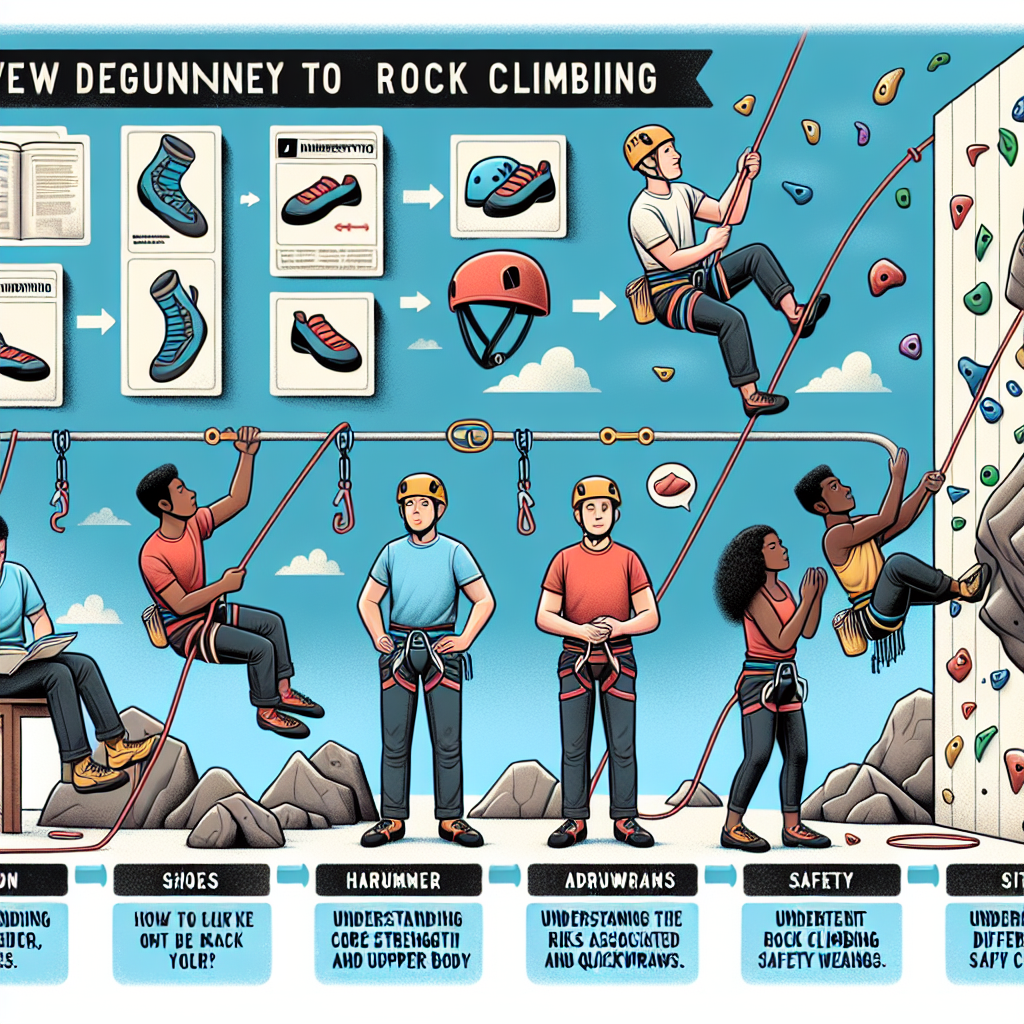Get ready to embark on an exciting adventure with “Rock Climbing: Understanding The Basics And Beyond”. This article is expertly crafted to guide you through your rock climbing journey, from understanding simple concepts to mastering complex techniques. Whether you’re a novice or an advanced climber, it offers invaluable insights that are sure to enrich your overall experience. With careful instructions, fascinating insights, and skills building strategies, this guide is set to transform your perspective on rock climbing. A thrilling ride awaits you, so get your gear ready and let’s scale the heights together!

What is Rock Climbing?
Rock climbing is a thrilling sport that involves scaling and maneuvering up and across natural rock formations or artificial rock walls, typically with the aid of equipment such as ropes and harnesses. The aim of rock climbing is not simply to reach the top, but to plot a path that challenges your strength, balance, and agility. Although climbing can be physically and mentally demanding, it is also an incredibly rewarding sport that immerses you in the beauty of nature and pushes you to your limits.
Defining Rock Climbing
At its core, rock climbing is an ambitious outdoor activity that requires a perfect blend of mental and physical abilities. It encompasses a broad range of styles, each with its unique challenges and rewards. From bouldering and trad climbing to sport climbing and mountaineering, the world of rock climbing offers an experience suited to every type of adventurer.
History of Rock Climbing
Though our ancestors had been scaling steep cliffs for millennia out of necessity, rock climbing as a sport only emerged towards the end of the 19th century. Initially, rock climbing was a component of mountaineering; climbers would practice on rock faces and cliffs to prepare for bigger expeditions. As climbing technology and techniques evolved, rock climbing branched off from mountaineering and came into its own as a hobby and a sport.
Different Forms of Rock Climbing
There are several forms of rock climbing, each with its unique charm. Traditional climbing involves climbers placing their own protective gear as they ascend, while sport climbing routes have pre-placed bolts. In bouldering, climbers navigate shorter routes, or “problems,” sans ropes and harnesses with crash pads for safety.
The Equipment
Rock climbing necessitates the use of specialized equipment to safeguard climbers and assist them on their ascent.
Essential Gear for Beginners
If you’re just starting out, your essential gear should include climbing shoes, a helmet, a harness, a belay device, and carabiners. Climbing shoes enhance grip, harnesses secure climbers with a rope, and belay devices help regulate the rope during climbs or falls.
Advanced Climbing Equipment
For advanced climbers tackling more challenging climbs, additional gear such as cams, nuts, and quickdraws are indispensable. These pieces of gear serve as placeholders that you attach your rope to, preventing dangerous falls.
Ensuring Safe and Efficient Use of Equipment
Equally important to having the right gear is knowing how to use it properly. Incorrect usage can lead to severe risks. Therefore, understanding how to handle, inspect, and maintain your equipment is crucial.
Climbing Techniques
Technique in rock climbing involves a lot more than just brute strength—it’s about the clever and efficient use of your body.
Basic Movements and Grips
Mastering foundational movements and holds like the ‘Three Points of Contact’, ‘Flagging’, ‘Smearing’, and ‘Crimping’ is crucial for every beginner. These basic techniques form the building blocks of any successful climb.
Advanced Techniques
As you progress on your climbing journey, you will learn advanced techniques such as ‘Dyno’, where you jump to reach a hold, and ‘Heel Hook’, a powerful foot placement technique that can help you ascend overhung structures.
Developing Your Own Climbing Style
Every climber gradually develops their unique style. Some people are strong and climb aggressively, while others focus on fluidity and conservation of energy. Experiment with what works for you and refine your strategy over time.
Safety Measures in Rock Climbing
Climbing can be inherently risky, but most hazards can be mitigated with the right safety measures.
Importance of Safety in Rock Climbing
Safety is paramount in rock climbing. With unpredictable conditions and sheer heights, a lax attitude towards safety can result in severe injuries, sometimes even fatal.
Safety Gear
Mandatory safety gear includes helmets to protect against falling rocks, harnesses for security, and belay devices that control the rope when climbing or descending. Remember, always double-check your safety gear before climbing.
Common Safety Practices
Safety practices include checking gear, understanding how your belay system works, communicating with your climbing partner, staying within your comfortable climbing grade, and learning fall techniques.

Physical Preparation for Rock Climbing
Rock climbing is a physically demanding activity that strains various muscle groups. Therefore, thorough physical preparation is crucial.
Types of Fitness Required
Rock climbing requires a blend of strength, endurance, flexibility, coordination, and balance. Raw power will only get you so far—you also need the ability to last the distance, stretch to reach distant holds, coordinate between your arms and legs, and balance your body on tricky footings.
Strength Training for Climbing
Strength training should target the muscle groups most used in climbing: the core, forearms, fingers, and lower body muscles. Specific exercises like pull-ups, push-ups, and finger strength drills form the backbone of climbing strength training.
Stretching and Flexibility Exercises
Being flexible allows you to navigate a wider range of motion, making climbing easier and more efficient. Incorporating stretching exercises into your routine, focusing on your hips, back, shoulders, and legs, is beneficial.
Mental Preparation for Rock Climbing
Climbing is as much a mental game as a physical one. Having mental strength can be the difference between a successful climb and a falter.
Overcoming Fear of Heights
While a certain level of fear is normal and healthy, excessive fear can be paralyzing. Methods to overcome it include gradual exposure, visualization exercises, and mindfulness techniques.
Building Mental Toughness
Mental toughness helps you persevere in the face of adversity. Climbing frequently, managing your fear, and becoming comfortable with falling can help build mental resilience.
Staying Focused During a Climb
Staying focused during a climb is critical. Lose concentration, and you risk making fatal mistakes. Developing a routine, meditating, and managing your energy can help maintain focus during strenuous climbs.
Outdoor Rock Climbing
Outdoor climbing exposes you to nature’s elements, making it a uniquely challenging and enriching experience.
Choosing a Climbing Location
Choosing a location depends on your skill level, climbing style, and the type of rock available. Researching the area, understanding the grading system, and talking to local climbers can help you select a suitable location.
Environmental Considerations
Outdoor climbing means venturing into delicate ecosystems. As climbers, it’s your responsibility to minimize your impact on the environment.
Tips and Strategies for Outdoor Climbing
Key strategies for outdoor climbing include starting with easier routes, understanding the weather forecast, carrying the required gear, and respecting nature and wildlife.
Indoor Rock Climbing
Indoor climbing allows you to hone your skills in a controlled environment before tackling outdoor adventures.
Differences between Indoor and Outdoor Climbing
While indoor climbing provides predictable conditions, outdoor climbing brings variables like rock type, weather, and wildlife. Indoor climbing is a great place to practice techniques and build fitness.
Getting Started with Indoor Climbing
Indoor climbing requires minimal equipment—usually just climbing shoes and a harness. Most gyms provide introductory classes, a great way to learn essential skills.
Preparing for Outdoor Climbing Through Indoor Practice
Practicing indoors can significantly enhance your outdoor climbing experience. You can work on your fitness, technique, and even rehearse planned outdoor routes.
Rock Climbing Ethics
As climbers, we must respect the outdoors and our fellow climbing community.
Understanding Climbing Culture
Climbing culture is founded on principles of mutual respect, support, and love for nature. Embrace this culture by being considerate to other climbers and caring for the climbing environment.
Leave-No-Trace Principles
Adhering to Leave-No-Trace principles, such as carrying out all waste, minimizing impact on vegetation, and avoiding the disturbance of wildlife, is critically important.
Respecting Other Climbers and the Climbing Environment
Climbing etiquette includes not hogging popular routes, keeping noise levels down, and not modifying routes for personal convenience.
Future of Rock Climbing
The future of rock climbing looks promising with increasing popularity, technological advancements, and even an Olympic debut.
Rock Climbing in the Olympics
The inclusion of rock climbing in the 2020 Tokyo Olympics marks a significant milestone for the sport, highlighting its growing popularity and acceptance.
Advancements in Climbing Technology
Technological advancements are making climbing gear safer, more efficient, and more comfortable. Expect continued innovation as the sport keeps expanding.
Increasing Popularity and Accessibility of the Sport
As more climbing gyms pop up and gear becomes more affordable, rock climbing is becoming more accessible than ever. It’s an exciting time for you to be part of the climbing community!

